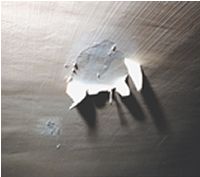 If patches of peeling paint on a ceiling or flakes of paint chips littering the room is a familiar site in your old house, your ceiling likely has a past that includes calcimine paint. Used throughout the 19th and into the early third of the 20th century, calcimine paint was a very popular and economical solution to give interior surfaces a fresh coating. Also referred to as kalsomine or distemper paint, it was a dried calcium carbonate product that, mixed with water and sometimes pigments and glue, formed an opaque, easy to use and fast-drying coating for walls and ceilings. These were the days of heating with coal and wood stoves, so walls and ceilings stained with soot quickly and calcimine was a quick and inexpensive cover-up during spring cleaning. Another aspect of its appeal is that it could be used immediately over new plaster as a coating. The plasters used during these times took anywhere from 30-60 days to fully “season” to the point that the PH-levels in the plaster compound would accept oil-based paint. Otherwise, the paint would become blotchy, blister and peel off as the curing plaster reacted with the oils in the paint. So calcimine provided a soft look to the stark plaster surface, and allowed builders and homeowners to “finish” their project immediately.
If patches of peeling paint on a ceiling or flakes of paint chips littering the room is a familiar site in your old house, your ceiling likely has a past that includes calcimine paint. Used throughout the 19th and into the early third of the 20th century, calcimine paint was a very popular and economical solution to give interior surfaces a fresh coating. Also referred to as kalsomine or distemper paint, it was a dried calcium carbonate product that, mixed with water and sometimes pigments and glue, formed an opaque, easy to use and fast-drying coating for walls and ceilings. These were the days of heating with coal and wood stoves, so walls and ceilings stained with soot quickly and calcimine was a quick and inexpensive cover-up during spring cleaning. Another aspect of its appeal is that it could be used immediately over new plaster as a coating. The plasters used during these times took anywhere from 30-60 days to fully “season” to the point that the PH-levels in the plaster compound would accept oil-based paint. Otherwise, the paint would become blotchy, blister and peel off as the curing plaster reacted with the oils in the paint. So calcimine provided a soft look to the stark plaster surface, and allowed builders and homeowners to “finish” their project immediately.
Being essentially chalk, the water-based mixture of calcimine paint contained minimal binders and glues for adhesion. Herein lies the problem for those of us dealing with peeling paint now, because this lack of active binder chemicals discourages modern paints from adhering. Over time, any paint coatings over a calcimine base will fail, chipping and peeling away modern paint coverings have nothing to “stick” to. Also, it is a very soft coating and all of today’s paint products are harder by comparison. A harder and stronger product cannot be layered successfully over a softer and lighter product because its surface tension will cause it to pull away. Environmental and climate changes (temperature shifts, unheated rooms during winter, moisture and humidity) also accelerate the delamination process significantly. The consequences of each of these scenarios are lots of peeling and large flakes of paint simply falling away from the wall or ceiling surface.
There are no easy or quick fix solutions to removing calcimine coatings. To achieve a smooth and long-lasting painted surface, as much of the calcimine as possible must be removed for any paint to adhere. This is a messy and time-consuming project, but well worth the effort. Another approach involves “locking” the calcimine onto the surface by sealing it with calcimine-coater or an oil-based primer. Both these approaches have advantages depending on your particular situation and energy level for the project. It really depends on if you are trying to cover over a problem or get rid of the problem, and how smooth you desire your finished ceiling to be. Simply repainting the surface will not, unfortunately, make your problems go away. You also do not want to begin to sandwich oil-latex-oil paints because they ‘move’ and react to environmental changes differently so this will only worsen your peeling problem.
 Peter Lord Plaster & Paint, Inc.
Peter Lord Plaster & Paint, Inc. 